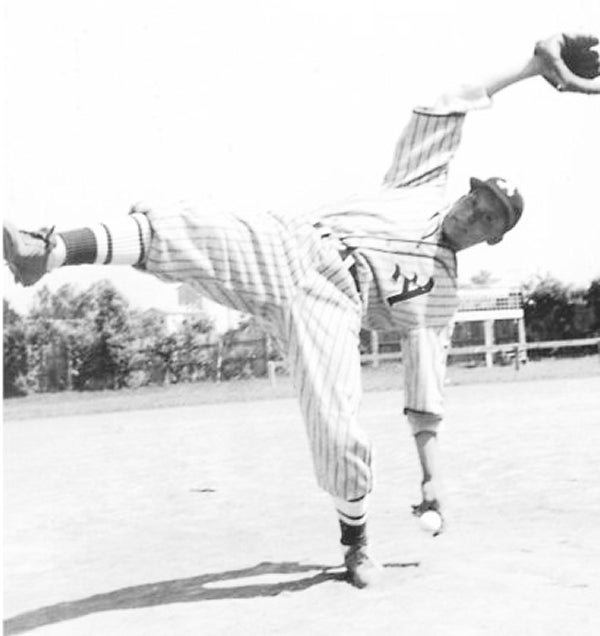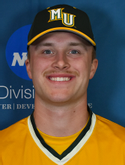College Baseball: Catawba’s 1941 team was one for the ages
Published 12:00 am Saturday, July 2, 2016

- www.thesnaponline.com J.W. “Lefty” Lisk rears back with his intimidating high leg kick and delivers his devastating curve ball that led Albemarle to the 1940 American Legion World Series championship. Lisk went on to pitch at Catawba and in professional baseball.
By Mike London
mike.london@salisburypost.com
Seventy-five years ago, the 1941 Catawba Indians put a baseball team on the field that beat a professional club.
Catawba’s roster, coached by Gordon Kirkland, was stacked. There was a strong-armed right fielder named Joe Ferebee, two future major leaguers in center fielder Raymond “Freck”Poole and third baseman Bobby Wilkins, and a host of athletes who would go on to star for minor league teams.
Some of the Catawba players actually were better in football. Tony Georgiana, a product of Altoona, Pa., who shared catching duties with Floyd Poole, would storm into the Catawba Sports Hall of Fame mostly for scoring touchdowns on the gridiron. Don Hanley, who also came from Altoona, helped the Indians as a baseball pitcher, but he was even better as an all-state football end.
Catawba’s accidental matchup with a pro team came on Saturday, April 26.
Catawba had traveled to Wilson to face Atlantic Christian College in a North State Conference game but was informed that the field was too wet to play. Catawba was ready to make the long ride back to Salisbury when it was discovered that a pro team was in town.
That team was the Reading Brooks, a Class B squad from Pennsylvania that competed in the Interstate League. Reading was nicknamed the Brooks because it was a Brooklyn Dodgers farm team. The Brooks were training at Wilson’s Municipal Stadium, a structure later to be known as Fleming Stadium.
The field at Municipal Stadium was playable, so a game was arranged.
Catawba pounded out 14 hits against the pros, including a towering homer by second baseman Red Hamil. Wilkins had three hits and stole three bases. A triple by Freck Poole put the Indians ahead to stay and Kirkland used four pitchers to hold off the Brooks, 11-10.
The Brooks would be led by a 19-year-old slugger named Carl Furillo that season, but the boxscore indicates the future Brooklyn right fielder wasn’t in uniform against Catawba.
Catawba scheduled 20 games that season, but cold and rain caused several early-season postponements.
The official Catawba record book says the Indians finished 12-2-1, but that ignores a 7-1 loss to the McCrary Eagles, a semi-pro team from Asheboro. The Eagles handed Catawba its first loss of the year.
Catawba’s opener was a 17-7 pummeling of High Point. Freck Poole scored four runs, but Thomas Davis, who may have been the best athlete on campus, stole the show with a homer and five RBIs. Freck Poole and Davis were the team’s veterans, seniors who had been playing since 1938.
Davis, who was raised in the Nazareth Children’s Home, also played for a strong Catawba football team and was the leading scorer and captain of a very good basketball team that had Ferebee, reserve outfielder Derwood Huneycutt and third baseman Bobby Wilkins in the starting lineup.
Davis, who had entered the Catawba record book for driving in a run in nine straight games in 1939, launched another homer in Catawba’s 12-0 romp over Connecticut. The McCrary Eagles brought Catawba back down to earth, but Catawba bounced back to beat arch-rival Lenoir-Rhyne, 4-0. Freck Poole homered against the Bears and John William Lisk (known as either J.W. or Lefty) threw a four-hitter.
Lisk, who could swing a bat as well as he pitched, was already a legend in 1941, as he’d led Albemarle to the national title in American Legion baseball in the summer of 1940. Playing at home, Albemarle beat San Diego for the championship. Lisk had a host of college offers, but after a visit from Kirkland, he was persuaded to make the short trip to Salisbury to play for Catawba. First baseman James Claude (J.C.) Blair Jr., who batted over .500 most of the 1941 season before settling for .444, went 4-for-4.
Lisk’s Catawba career would be interrupted by World War II, but he would star for the Indians before and after the war.
Catawba whipped Virginia Tech, and 7-2, and then took on an even more powerful team in the North State Conference — Elon. The teams played a two-game series at Elon in early April. Elon beat Lisk, 5-3. The second game was stopped by weather with a 5-5 deadlock.
Elon would win the North State Conference by virtue of that series. Elon would lose only four games that season — one to Duke, one to East Carolina, one to a semipro squad, and one to Catawba.
Catawba’s next interesting game was an 8-7 comeback win at Lenoir-Rhyne in the traditional Easter Monday game. Freck Poole shocked everyone by hitting a ball into the concrete stands behind the right-field fence and Catawba overcame a three-run homer by L-R’s Burt Barger.
That was a Lenoir-Rhyne squad that included at least three players who would become famous high school coaches — first baseman Frank Barger, right fielder Burt Barger, and left fielder Dan Hamrick. Barger would become North Rowan’s first football coach. Hamrick would coach athletes such as Billy Ray Barnes at Landis High in the 1950s glory days of the Yellow Jackets. Frank Barger, a China Grove native, would coach the Hickory High football team to 273 victories in 31 seasons.
A crowd of 600 turned out to see Catawba’s second meeting with Lenoir-Rhyne at Newman Park. It was declared Stanly County Day to honor Lisk, Blair and shortstop Bobby Deese. Catawba didn’t disappoint, overpowering the Bears, 24-4. Ferebee clobbered a homer, and Freck Poole made two astounding catches in center field.
After Clayton Gaddy pitched Catawba to a 3-1 win against Appalachian, the Indians were ready to challenge Elon again. This time the teams would play on back-to-back days at Newman Park. Dave Kesler pitched Catawba to a 5-2 win in the opener, but Elon won, 6-2, on the second day. That game included an Elon player slugging an umpire from behind during an argument at second base, but Elon won, and with a 2-1-1 record against Catawba, the Fighting Christians, as Elon was known, were headed to the North State Conference title.
Catawba’s final game in 1941 was on May 6 and was the third meeting with Lenoir-Rhyne. Catawba won, 11-6, with Freck Poole leaning on a wire fence to make a game-ending catch. Davis hit a home run in his final game for Catawba, but it was Ferebee who had the memorable outing. He had four hits, including a homer and two triples.
That wasn’t supposed to be the season-ender. Catawba had another game scheduled with Appalachian, but it was canceled when Appalachian’s captain, Ernie Safrit, a three-sport star, died tragically. Safrit had been a star athlete at Albemarle High.
That would be the last normal Catawba baseball season for a while. The bombing of Pearl Harbor came seven months after Catawba finished a satisfying school-year sweep of rival Lenoir-Rhyne that also included a football victory and two basketball wins.
Catawba would play a limited baseball schedule during the war years from 1942-45 and rival schools such as Elon shut down completely until 1946.
Freck Poole and Davis were signed by the Philadelphia Athletics and reported to Philadelphia within days of finishing their Catawba careers.
•••
Poole, who was 21, was sent to Lancaster, Pa., to play Class B ball and did well, batting .284 in 106 games.
On September 9, 1941, at Philadelphia’s Shibe Park, Poole made his major league debut when manager Connie Mack sent him to the plate as a pinch-hitter in the bottom of the ninth to face Cleveland fireballer Bob Feller. Poole was called out on strikes.
Poole didn’t get his second at-bat until Sept. 16. Again he pinch-hit in the last of the ninth, this time in a 9-8 loss to the St.Louis Browns. This time he made contact, but it would be his last MLB at-bat for six years.
Like a lot of other young Americans, Poole would be in the U.S, Army in 1942.
After the war, in 1946, Poole batted .308 for the Savannah Indians of the South Atlantic League.
In 1947, he was called back to Philadelphia. He went to the plate 14 times, all as a pinch-hitter, got three hits and walked once. He scored one run in the big leagues.
Poole’s career in pro ball, almost all of it in Class B, lasted until 1954. He played in 1,102 minor league games and batted .295.
Poole retired from Isenhour Brick. He died in Burlington in 2006.
•••
Davis was 22 when he reported to Philadelphia. He spent the 1941 season with the Class C Newport News Pilots and the Class B Lancaster Red Roses where he and Poole were teammates. Davis never played in the major leagues, but he had an exceptional minor league career.
Davis wasn’t called into military service for reasons that aren’t known, but he got his release from the Athletics and returned to Rowan County in 1942. He pounded the ball, hitting .345 for the Landis Senators while he fixed machinery at Linn Mill and at Cannon Mills No. 7.
In December, 1942, Davis was hired by the city of Salisbury as a policeman, but then the baseball bug bit him again and he resigned from the force and signed with the Detroit Tigers. Playing in 129 games for the Class B Hagerstown Owls in 1943, Davis batted.345 with 16 homers.
Davis climbed the minor-league ladder as high as Double A ball in 1944 and 1945. He would play in 1,648 minor league games, finally retiring after the 1954 season when he was 35. He finished his minor-league career with 120 homers and a .305 batting average.
•••
The 1941 Catawba Indian who had the longest stay in the major leagues was Wilkins, a speedy infielder from Denton in southern Davidson County.
World War II had ravaged MLB rosters as many players who weren’t in the service were working in factories in the defense industry.
Wilkins left Catawba and started his professional career in 1943 when he was 20.
He made the opening-day roster of the decimated Philadelphia Athletics for the 1944 season by showing great speed and defensive skills in spring training.
He was shipped back to the minors after playing 25 games for the 1944 Athletics, mostly as a pinch runner and defensive replacement at shortstop. He went 6-for-25 at the plate during his time in the majors.
But in 1945, Wilkins spent the entire season with the Athletics. He was a respectable 40-for-154 (.260) at the plate, scored 22 runs and had six doubles.
Wilkins didn’t play in the majors after 1945, but he had a fine career in the minor leagues. His last season as a player was 1954. He played in 1,017 minor league games, has 872 hits and
He set fielding records with the Shreveport Sports in the Class Double A Texas League. He played four years for the Sports and broke a league record in 1949 by handling 159 consecutive chances at shortstop without an error. In 1951, he broke another Texas League record by starting 71 double plays.
After he retired in 1954, he spent the rest of his life in Shreveport, La. Wilkins finished his education at Duke, graduated from the FBI Academy and went to work for the Caddo Sheriff’s Department. After he retired, he coached baseball. He died in 2010.
•••
Deese was such a good shortstop for the 1941 Catawba team that Wilkins, a future major league shortstop, played third base for the Indians. Deese started his pro career in 1942, but he lost 1943-45 to the war. He played in the minors from 1946-1952, mostly in the Class D North Carolina State League. In the NCSL, he wore the uniforms of the Albemarle Rockets, Landis Spinners, Elkin Blanketeers, Lexington Indians and Statesville Owls.
•••
Blair was 20 when he batted .444 for Catawba in 1941. The 6-foot-2 first baseman began his pro career in 1942 with the Class C Petersburg Rebels and powered 22 home runs in his debut while batting .360.
He may have enjoyed a stellar career if not for the war, but he lost the 1943-45 seasons to military service. After the war, he had two fine seasons for the Burlington Bees in the Class C Carolina League, but his career was over by 1951.
He died in 2008.
•••
Lisk returned to Catawba in 1942 and fired a no-hitter against Atlantic Christian. He lost 1943-45 to the war but came back to Catawba for the 1946-47 seasons and starred mostly as a hitter. He smacked grand slams in 1946 and 1947 and led Catawba to North State Conference titles both years.
Lisk played pro ball from 1947-49. Wearing the uniform of the Salisbury Pirates in the summer of 1948, Lisk powered 21 homers, including three in one game.
He died in 2007.
•••
Gaddy, who pitched the big win against Appalachian, served in the U.S. Army Air Corps during World War II as a P-47 fighter pilot. He died in 2015 at 95 in his hometown of Wadesboro.
•••
Georgiana died in 2014 at 93. He enjoyed a Hall of Fame career as a high school coach in Delaware. One of the players he helped coach was Dallas Cowboys All-Pro defensive lineman Randy White.
Hanley, who died in 2002, was inducted into the Catawba Hall of Fame in the same class as Georgiana. They were football co-captains at Catawba and were co-head coaches at a Delaware high school for 22 seasons.
•••
Kesler, a Rockwell native, served in World War II as a military policeman and was awarded a Bronze Star. He became a deputy with the Rowan County Sheriff’s Department. He died in 2002.
•••
Ferebee graduated from Catawba in 1942. Not long after that, he was in a bunk at Norfolk Naval Training Station. He’d joined boxing champ Gene Tunney’s Naval Physical Fitness Program and eventually he would train thousands of sailors — 160 at a time — at Idaho’s Farragut Naval Training Station.
Ferebee played pro baseball after the war for the Concord Weavers, Salisbury Pirates and Albemarle Rockets, but his career as a Salisbury Boyden High coach was taking off by 1947.
Pfeiffer’s baseball facility is now Ferebee Field, and Ferebee, 97, coached 677 baseball wins at Pfeiffer as well as 694 victories with Spencer, Salisbury, Albemarle and Rowan County American Legion teams. The legend remains prouder of his World War II service than all those baseball wins.





